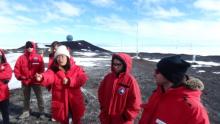Update
A PDF is now available of Josh Heward's presentation on "Tough Tardigrades". You can access this and other events on the PolarConnect Archives site: https://www.polartrec.com/polar-connect/archive
What Are They Doing?
 A view looking up Taylor Valley. Lake Hoare, Dry Valleys, Antarctica. Photo by Robin Ellwood.
A view looking up Taylor Valley. Lake Hoare, Dry Valleys, Antarctica. Photo by Robin Ellwood.
The McMurdo Dry Valleys Long-Term Ecological Research (MCM LTER) Program is an interdisciplinary and multidisciplinary study of the aquatic and terrestrial ecosystems in an ice-free region of Antarctica. MCM joined the National Science Foundation's LTER Network in 1993 and is funded through the Office of Polar Programs in six year funding periods. The McMurdo Dry Valleys (77°30'S 163°00'E) on the shore of McMurdo Sound, 2,200 miles (3,500 km) due south of New Zealand, form the largest relatively ice-free area (approximately 4,800 sq km) on the Antarctic continent. These ice-free areas of Antarctica display a sharp contrast to most other ecosystems in the world, which exist under far more moderate environmental conditions. The perennially ice-covered lakes, ephemeral streams and extensive areas of exposed soil within the McMurdo Dry Valleys are subject to low temperatures, limited precipitation and salt accumulation. The dry valleys represent a region where life approaches its environmental limits, and is an end-member in the spectrum of environments included in the LTER Network. The overarching goal of MCM LTER research is to document and understand how ecosystems respond to environmental changes.
Where Are They?
 Crary Lab at McMurdo Station, Antarctica. Photo by Sarah Diers.
Crary Lab at McMurdo Station, Antarctica. Photo by Sarah Diers.
We are based out of McMurdo Station and spend time between the Crary Laboratory and the field camps in Taylor Valley. The field camps include F6 camp, Fryxell camp, and Hoare camp.
The McMurdo Dry Valleys are located on the western coast of McMurdo Sound and form the largest relatively ice-free area on the Antarctic continent. The perennially ice-covered lakes, frozen alpine glaciers, and extensive areas of exposed soil and permafrost within the McMurdo Dry Valleys are subject to low temperatures, limited snowfall, and salt accumulation.
Latest Journals

Byron is an evolutionary ecologist in the Department of Biology at Brigham Young University where he teaches Biology, Molecular Biology, and Evolutionary Biology classes. Byron’s approach to understanding biology involves inferring evolutionary and ecological processes from patterns in nature. His most recent projects involve fieldwork in Antarctica, where he and his colleagues on the McMurdo Long Term Ecological Research project are studying the relationship between biodiversity, ecosystem functioning, and climate change. Byron gets stoked about science education and loves interacting with K-12 students and teachers. When he’s not freezing his butt off in the McMurdo Dry Valleys or southern Transantarctic Mountains, he likes spending time with his family and friends in Utah’s wild places.





